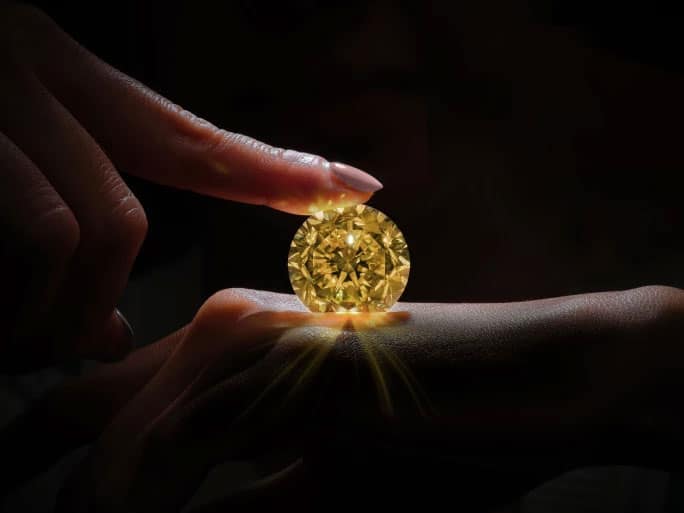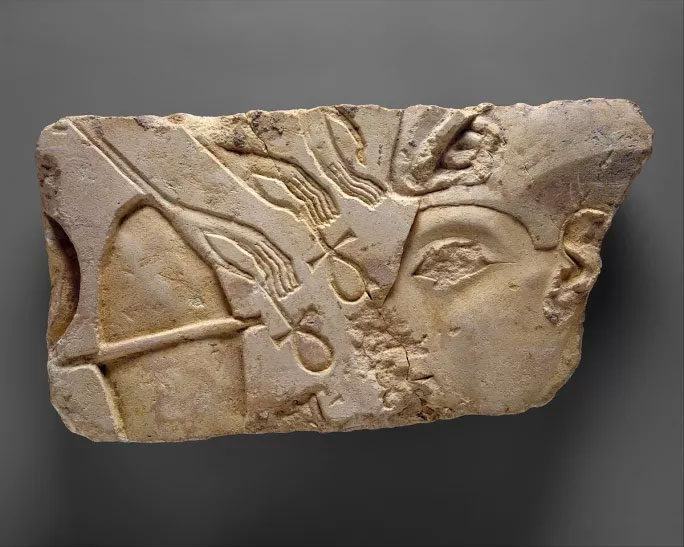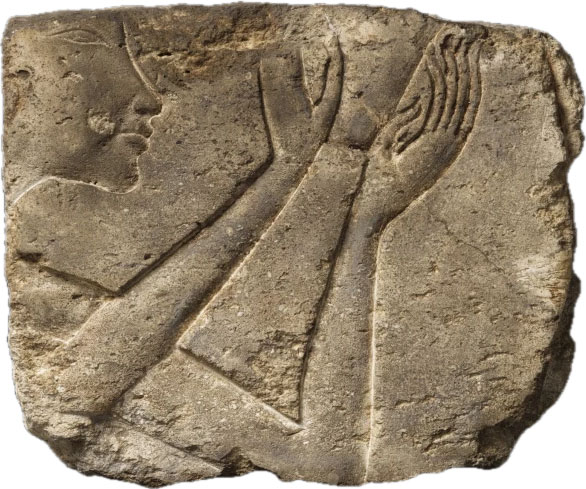

Thirteen centuries before the birth of Christ, during ancient Egypt’s Eighteenth Dynasty, Aten became the central diety of a new monotheistic religion: Atenism. It was a revolutionary development brought forward by the Pharaoh Akhenaten whose brief reign infused a new vitality into the moribund religion, art and culture of an ancient civilisation. A remarkable king, who historians have alternately described as a visionary and a despot, Akhenaten changed the history of Egypt with his individualistic vision. By elevating Aten, who had been present in past mythology as the disc of the sun – an aspect of the traditional sun god Ra – to the status of the state’s sole cult deity, Akhenaten inspired an artistic Renaissance with a distinctive aesthetic. The moment of Aten’s elevation has inspired comparisons to the emergence of Judeo-Christian monotheism and inspired deep theological discussions about the evolution of religious thought and belief.
Revered as both a creator and nurturing spirit, Aten first appears in a Twelfth Dynasty manuscript which describes a deceased king (Sinuhe) who rises skyward to merge with the disc of the sun. During the reign of Akhenaten’s father, Amenhotep III, Aten had appeared in the form of one of Egypt’s many gods, the falcon-headed Ra. Five years after Amenhotep IV took the throne he re-named himself Akhenaten, which roughly translates to “living image of Aten.” In light of Aten’s new supreme status, it was decreed that physical depictions of the god himself were idolatry and new ways to symbolise Aten’s omnipresence were developed. This new symbolism also helped clear the way for innovative depictions of the Pharaoh and his family, who had distinctive features.
Akhenaten soon announced his plans to build a massive new capital dedicated to the cult of Aten called Akhetaten. Known later as Amarna, it was built on an unlikely site: an uninhabited desert plateau surrounded by cliffs. The construction of splendid palaces and temples open to the sky to enable the worship of Aten progressed rapidly due to the use of small stone blocks rather than the massive sandstone blocks used in earlier periods. In the new city’s many temple reliefs and devotional images a stylised solar disc with incised rays ending in human hands came to represent Aten’s eternal presence and all-encompassing power.
In a fragment from a limestone temple relief in the collection of the Metropolitan Museum of Art, Aten’s hands reach towards the face of a woman who has been identified by scholars as Nefertiti, Akhenaten’s consort and favorite queen. In this depiction two of Aten’s rays in the form of hands hold an ankh – a symbol of eternal life – to her nose and mouth while a third reaches towards the divine cobra decorating her forehead. This manifestation of Aten’s protective power also emphasises his connection with the idea of eternity and eternal life.

Another relief fragment from late in Akhenaten’s reign, portrays the head of another royal consort, probably Queen Kiya, whose slender, curving fingers offer a bouquet to Aten. Her stylised features, which include an oval chin, slender upturned nose and an almond-shaped eye, are typical of depictions of the royal family and court during Akhenaten’s reign.
Aten was widely celebrated in hymn-poems, most famously including the Great Hymn to the Aten. Possibly written by Akhenaten himself, it has a striking resemblance to Psalm 104 of the Judeo-Christian bible. One set of lines emphasises both the balance between Aten’s controlling power and power over death and his mesmerising beauty:
[THOSE ON] EARTH COME FROM YOUR HAND AS YOU MADE THEM. WHEN YOU HAVE DAWNED THEY LIVE. WHEN YOU SET THEY DIE; YOU YOURSELF ARE LIFETIME, ONE LIVES BY YOU. ALL EYES ARE ON [YOUR] BEAUTY UNTIL YOU SET.
The Great Hymn to the Aten also reminded Akhenaten’s subjects of the Aten’s many other qualities including its reliability and ability to banish the dark forces of evil with his rays. With its focus on Aten as the only God and Creator, the hymn is unlike earlier poems in that it does not mention any of Egypt’s other deities, since they had been banished.
During Akhenaten’s late reign a plague spread across the Near East, claiming the lives of numerous royal family members and officials, and weakening the king’s power. By the time he died a resurgence of older cults – including the cult of Amun which Akhenaten had repressed – had diminished the influence of Atenism. Many of the block temples that Akhenaten had built, including one at Thebes, were taken down to provide material for new buildings and any remaining inscriptions to Aten were defaced. Traditional polytheistic worship soon returned and Akhenaten was posthumously declared to have been a heretic.

The legacy of Atenism remained largely dormant until archaeological explorations by Europeans in Egypt created fresh interest in the 17th century. Louis XIV, who ruled France from 1643 until 1715, called himself “The Sun King,” and modelled many aspects of his reign, including the founding of a new capital city at Versailles, on Akhenaten’s powerful vision. Through the lavish use of gold – the solar metal – throughout his palace at Versailles, Louis extended and expanded on the connection between sunlight and centralized power.
When he met with dignitaries in the “Hall of Mirrors” the omnipresence of reflected light supported the French king’s dazzling presence in much the same way that Akhenaten’s open-roofed temples had connected his power to the sun. It should also be noted that Louis XIV was an avid collector of fine gems who often wore the legendary 69-carat “French Blue” diamond, which was set in gold and suspended from a neck ribbon.
Atenism’s true legacy, which is the revelation of power and symbolism represented by the sun and its rays, remains potent today. The god Aten, a personification of the sun, remains an eternal symbol of light, power and creation.
POSTED WITH PERMISSION. COPYRIGHT SOTHEBY’S. Click to read original article.

